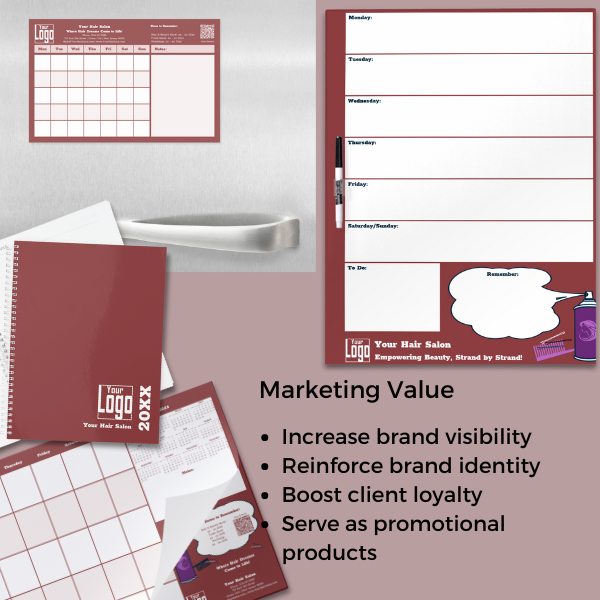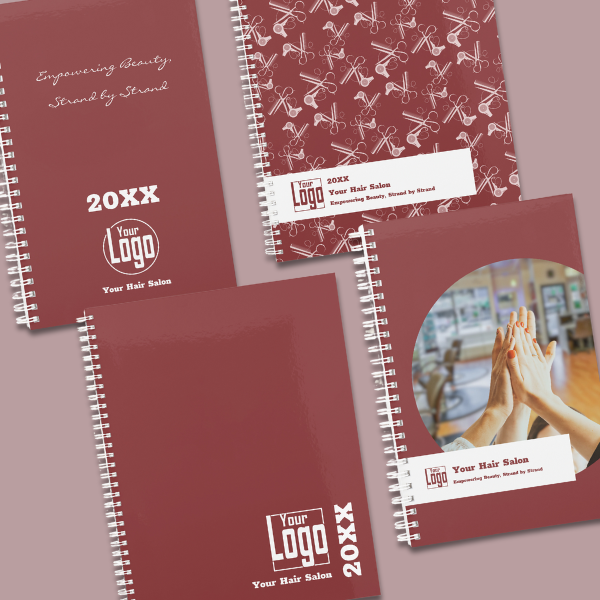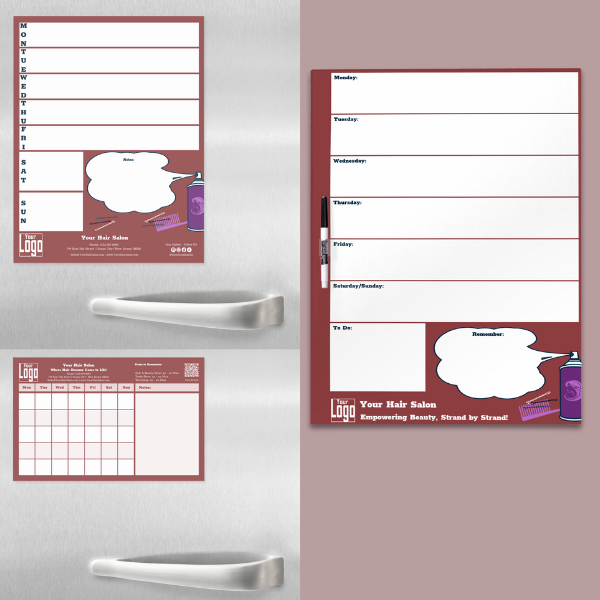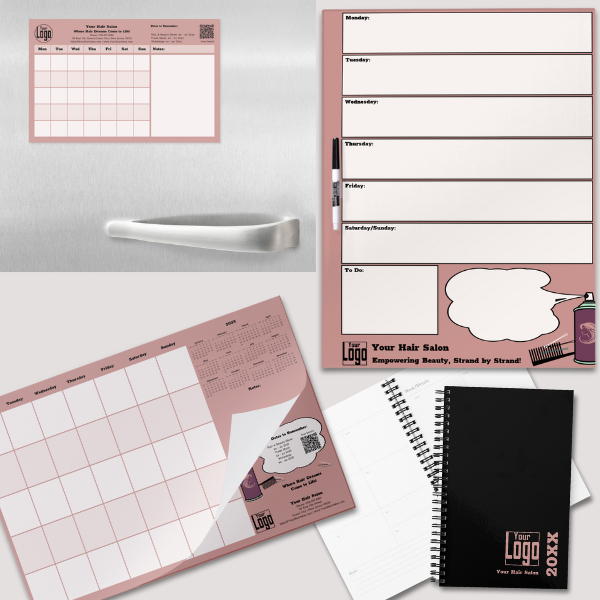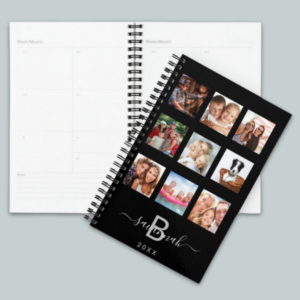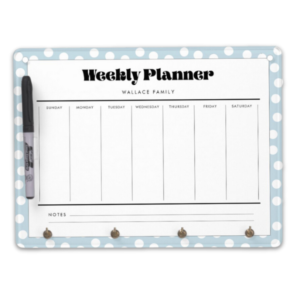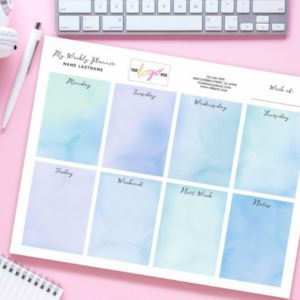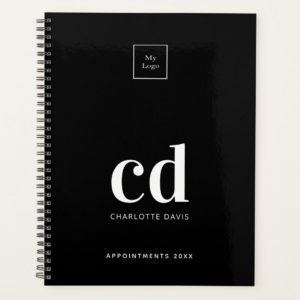A planner is an essential organizational tool designed to help individuals and businesses track tasks, appointments, goals, and deadlines. From a small business perspective, planners play a crucial role in streamlining day-to-day operations, improving productivity, and staying focused on long-term objectives. Beyond their practical use, planners also serve as marketing tools that reflect a company’s brand identity and values.
Article Content:
1. The Marketing Value of a Planner
For small businesses, planners are more than just organizational tools; they can be highly effective marketing assets. Custom planners—featuring a company’s logo, colors, and unique content—can:
- Increase brand visibility: When clients or employees use planners branded with your company’s name or logo, it serves as a constant reminder of your business.
- Reinforce brand identity: The design, tone, and content of the planner reflect your company’s personality and values, giving customers or employees a tangible connection to your brand.
- Boost client loyalty: Offering a beautifully designed planner as a gift can enhance customer loyalty and show clients that you value their business.
- Serve as promotional products: Companies often gift planners at events, trade shows, or during the holiday season. These planners can be a memorable, useful, and budget-friendly way to market your business.
2. Cover Design and Template Layout
When designing a planner for small business purposes, the cover design should be both visually appealing and brand-consistent. A well-designed cover can attract attention and create a positive first impression. Common elements to include on a cover are:
Interior Template Layout
Inside, the layout of the planner is critical to ensuring it’s user-friendly and functional. Key elements to include:
- Monthly Calendars: Give an overview of each month for quick planning of key events, deadlines, and goals.
- Weekly and Daily Pages: Break down tasks and appointments into manageable segments. Some planners may feature time blocks for hour-by-hour scheduling, while others focus on to-do lists.
- Goal-Setting Sections: Allow space for setting and reviewing business goals. This might include personal development, project tracking, or sales objectives.
- Notes Pages: Provide free-form space for brainstorming, creative ideas, or additional notes.
Planners designed for business use might also include sections for financial tracking, project management, and client follow-up reminders.
3. Benefits of a Planner
Using a planner offers many benefits, especially for small business owners:
- Improved Time Management: Planners help businesses prioritize tasks, schedule meetings, and meet deadlines more efficiently.
- Increased Productivity: With clear objectives and timelines in place, teams can focus on what matters most.
- Goal Tracking: By recording business goals in the planner, businesses can track progress and make adjustments as needed.
- Better Organization: Planners offer a structured space to keep important notes, deadlines, and appointments all in one place.
- Reduced Stress: Knowing tasks and deadlines are organized in one place reduces the anxiety that comes with managing a business’s moving parts.
Who Can Benefit From a Planner?
- Small Business Owners: For entrepreneurs managing multiple aspects of their businesses, planners help juggle tasks, financials, and client communications.
- Employees: Using planners boosts personal organization, helping employees manage workloads effectively.
- Clients and Partners: Gifting a planner to clients or partners is both practical and memorable, serving as a functional business tool and a reminder of your relationship.
4. Types of Planners
Small businesses can choose from a variety of planner types based on their needs and industry requirements:
Calendar Books:
These traditional planners feature monthly, weekly, and daily calendars. They are ideal for long-term project tracking and scheduling.
Dry Erase Boards:
Often used in offices, dry erase planners offer a large, reusable surface for brainstorming, task lists, and collaborative planning. These are excellent for project management or tracking business KPIs.
Paper Pads:
Simple, portable, and customizable, paper pads are ideal for jotting down quick notes, to-do lists, or immediate action items. They can complement a more detailed planner or be used as standalone tools.
Yearly Planners:
These planners provide a macro view of the year, making them useful for high-level business strategy, budgeting, and major project timelines.
Monthly Planners:
For businesses that operate on short-term cycles, such as retail businesses or those with frequent projects, monthly planners help track goals and deadlines in a manageable format.
Weekly Planners:
Weekly planners are perfect for task-oriented businesses that need to manage weekly deliverables and appointments. They provide a detailed view of each week’s priorities and goals.
All in all, from improving daily operations to serving as a marketing tool, planners are an invaluable asset for small businesses. Choosing the right type of planner and customizing it for your business can significantly improve productivity, organization and brand visibility. Whether it’s a sleek, branded calendar book or a functional dry erase board, a thoughtfully designed planner can drive success in a meaningful and organized way.
5. Introducing Planner Designs by KBM D3signs
Yearly Business Planner Book – Cover Designs by KBM D3signs
Introducing KBM D3signs’ Yearly Business Planner Book collection, which includes stunning cover designs inspired by the Smoky Topaz Hair Salon Biz Cards & Marketing Items. These designs are available in both 5.5” x 8.5” (small) and 8.5” x 11” (standard) sizes, offering a range of creative, business-oriented templates. Whether you prefer a minimalistic look or an intricate design, KBM D3signs caters to various aesthetic preferences and branding needs.
Cover Design Ideas::
- Minimalist Look: This cover features a smoky topaz and burgundy background, with the company logo, name, and year neatly arranged in a block at the bottom-right corner. The year is displayed vertically, requiring a slight tilt of the head for easy reading. This sleek design radiates professionalism and simplicity.
- Custom Photo Design: A dynamic and eye-catching layout, this design includes a round photo slightly off-center, partially cropped on the right side. A white text field slides in from the left, covering a portion of the lower half, allowing space for the logo, company name, and a business motto. It’s a stylish and personalized option for showcasing the team or business location.
- Patterned Design: Set against a burgundy background, this cover features a soft rose pattern of hairdressing tools, tying into the profession’s identity. A white text box, covering four-fifths of the cover width, provides ample space for the company logo, year, name, and motto. It’s a perfect blend of elegance and relevance, making it an attractive option for businesses in the beauty industry.
Each design includes a QR-code on the back cover for easy access to the company website and contact details, making it functional as both a planner and a promotional tool.
Dry Erase Magnetic Sheet Designs by KBM D3signs
KBM D3signs also offers a range of Dry Erase Magnetic Sheets, which are ideal for salons and other small businesses. Available in 8.5” x 5.5” (half-letter) and 8.5” x 11” (letter) sizes, these sheets are part of the Smoky Topaz Hair Salon collection. The smaller version is perfect for sticking to a fridge, while the larger one provides more space for weekly planning.
- Landscape Design: This version offers a layout with five rows of cubes under each weekday, perfect for weekly or monthly planning, with additional fields for notes.
- Portrait Design: Ideal for detailed weekly planning, this sheet features larger fields for weekdays and smaller spaces for weekends, along with a dedicated notes section. It also leaves room for the salon’s logo, name, and contact details.
- For those needing more space, KBM D3signs also provides a 22″ x 16″ dry erase sheet for permanent wall mounting, designed for detailed weekly planning with a focus on ease of use and branding.
Large Tearaway Paper Pad Planner
KBM D3signs’ Large Tearaway Paper Pad Planner is an excellent choice for businesses that require flexibility. With its generous 12” x 18” size, this planner is ideal for mapping out weekly or monthly schedules. Five large fields per day allow for detailed planning, whether it’s for entire weeks or specific daily time slots.
Additional features include:
- A small 2025 calendar for quick date referencing
- A “hairspray cloud” graphic for special notes or reminders
- A QR-code for event schedules or promotional links
- A field for the salon’s logo, motto, and contact details, making it a powerful marketing tool in workshops, shows, or in-house promotions.
All in all, from personalized business planner books to functional dry erase boards and paper pads, KBM D3signs offers versatile and visually striking designs to meet any business organization and marketing needs. These planners not only keep your team on track, but also serve as stylish promotional items that increase both productivity and brand visibility.
In Conclusion
At the Cocoon It! Store by KBM D3signs on Zazzle puts all the branding elements and color schemes in your hands. Whether you’re choosing products with a QR code – where the second color is limited to black or white for optimal contrast – or exploring the vast array of customizable elements through the “Edit further” link, your brand’s unique identity is yours to define.
We use color tools to help you choose the perfect hues, and for additional inspiration, explore our curated collection of color palette ideas. Our commitment to customization goes beyond placeholders-almost all elements can be customized to match your chosen colors.
If you need additional assistance customizing or transferring designs to different products, or if you have a unique vision that requires a custom design, we are just a message away. At Designs by KBM D3signs, we go beyond providing marketing materials; we empower you to shape and showcase your brand with creativity and personalization.
Shop at Zazzle Store
Cocoon It! – Business Planners
Show off your personal style or post a review!
-

6 Winter Marketing Ideas for Small Businesses
Read the post …: 6 Winter Marketing Ideas for Small Businesses -

6 Offline Summer Marketing Ideas for Small Businesses
Read the post …: 6 Offline Summer Marketing Ideas for Small Businesses -

What is Seasonal Marketing? A Guide for Small Business Offline Success
Read the post …: What is Seasonal Marketing? A Guide for Small Business Offline Success
6. Frequently Asked Questions (FAQs) About a Planner
By understanding the various types and uses of planners, you can choose the best one to meet your organizational needs, whether for personal use or business purposes.
A planner is an organizational tool designed to help you schedule tasks, appointments, and deadlines. Planners come in various forms, including daily, weekly, or monthly formats, and can be physical (paper-based) or digital. They help users stay on top of their goals, prioritize tasks, and manage their time efficiently.
Planners come in various formats, each designed for different purposes:
– Calendar books: Physical planners with monthly, weekly, and daily sections for detailed scheduling.
– Dry erase boards: Reusable planners, often mounted in homes or offices, for tracking tasks and plans in real-time.
– Paper pad planners: Tearaway sheets that allow for easy weekly or daily planning.
– Yearly, monthly, and weekly planners: Planners focused on long-term, mid-term, and short-term goal tracking and scheduling.
Using a planner offers multiple benefits:
– Improved time management: Helps organize tasks and appointments, preventing overlapping schedules.
– Increased productivity: Ensures focus on important tasks by setting clear priorities.
– Goal tracking: Keeps goals and deadlines visible, making it easier to track progress.
– Stress reduction: Organizing your tasks in a planner helps reduce anxiety by keeping all necessary information in one place.
Planners can be used by anyone, but they are particularly beneficial for:
– Small business owners: To manage multiple tasks, meetings, and goals.
– Students: To organize class schedules, assignments, and exams.
– Professionals: To keep track of appointments, deadlines, and projects.
– Families: To manage household tasks, events, and to-do lists.
A planner typically includes:
– Appointments and meetings
– To-do lists
– Deadlines for projects or goals
– Notes and brainstorming sections
– Goal-tracking pages for long-term and short-term goals
– Reminders for important events or actions
When selecting a planner, consider:
– Time frame: Do you need a daily, weekly, monthly, or yearly planner?
– Portability: Smaller planners are easier to carry, while larger planners offer more space for detailed planning.
– Design and layout: Choose a layout (horizontal or vertical) that aligns with how you prefer to view your tasks and appointments.
– Customization: If you need a planner tailored to specific needs, consider those with customizable sections like goal trackers or notes pages.
Absolutely. Planners are excellent tools for managing business tasks, appointments, projects, and team collaboration. Many businesses customize planners to include branding, financial tracking, or project management features, making them essential for staying organized and professional.
To use a planner effectively:
– Set aside time each day or week to update it.
– Prioritize tasks based on importance and deadlines.
– Break down large projects into smaller tasks and schedule them over time.
Regularly review and adjust your plans based on changes or progress.
Yes, there are planners specifically designed for team use, such as dry erase boards for office environments or digital planners with shared access. These allow teams to track progress, assign tasks, and manage projects collaboratively.
Yes, planners are popular promotional items, especially for businesses. Customized planners with a company’s logo, contact information, and branding can be given to clients, partners, or employees as practical gifts that enhance brand visibility while offering functional value.
A calendar provides a simple view of dates and holidays, while a planner offers a more detailed space for managing tasks, goals, appointments, and deadlines. Planners often include additional sections for notes, goal setting, and reminders that aren’t typically available on standard calendars.
Yes, many planners include sections specifically designed for goal-setting. These pages allow you to define personal or business goals, track progress, and set deadlines, helping you stay focused and organized.
It’s best to update your planner regularly:
– Daily: For detailed scheduling and to-do lists.
– Weekly: For reviewing priorities and setting tasks for the upcoming week.
– Monthly: For longer-term planning, such as setting deadlines or tracking progress on major projects.
Yes, many planners are made from recycled paper or come with reusable features, such as dry erase boards or digital planners, which reduce paper waste.
-

What Is A Brand Partnership? – A Small Business Perspective
Read the post …: What Is A Brand Partnership? – A Small Business Perspective -
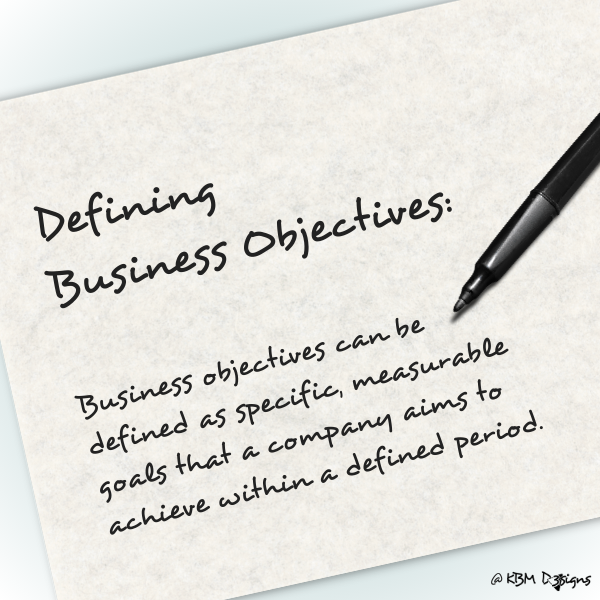
What Are Business Objectives?” Perspective Of A Small Business
Read the post …: What Are Business Objectives?” Perspective Of A Small Business -

What Is A Focus Group Market Research? – SMB Perspective
Read the post …: What Is A Focus Group Market Research? – SMB Perspective


